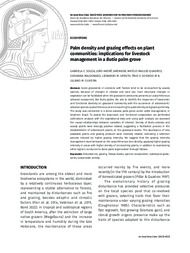Palm density and grazing effects on plant communities: implications for livestock management in a Butia palm grove.
Palm density and grazing effects on plant communities: implications for livestock management in a Butia palm grove.
Author(s): SOUZA, G. C.; JARENKOW, J. A.; RAGUSE-QUADROS, M.; MALDONADO, G.; URRUTH, L. M.; SOSINSKI JUNIOR, E. E.; OLIVEIRA, J. M.
Summary: Some grasslands in ecotones with forests tend to be encroached by woody species, because of changes in climate and land use. Such structural changes in vegetation can be facilitated when the grassland community presents an autochthonous arboreal component, like Butia palms. We aim to identify the responses of taxonomic and functional diversity on grassland community with the occurrence of arborescent/ arboreal species (autochthonous and encroaching) to palm density and grazing intensity. The study was conducted in a Butia odorata palm grove under cattle management, in Southern Brazil. To assess the taxonomic and functional composition we performed ordinations analysis with the vegetational data and using path analysis we assessed the causal relationships between variables of interest. Density of Butia odorata and woody plants were strongly positive related, suggesting a facilitation process in the establishment of arborescent plants on the grassland matrix. The abundance of less palatable plants and grazing pressure were inversely related, indicating a selection process induced by higher grazing intensity. We suggest that the grazing intensity management must be based on the autochthonous tree density, applying higher grazing intensity in areas with higher density of encroaching plants, in addition to maintaining other regions conducive to Butia palm regeneration through fallows.
Publication year: 2023
Types of publication: Journal article
Keywords: Bioma Pampa, Butiá, Multidisciplinary, Pastagem, Vegetação
Observation
Some of Embrapa's publications are published as ePub files. To read them, use or download one of the following free software options to your computer or mobile device. Android: Google Play Books; IOS: iBooks; Windows and Linux: Calibre.
Access other publications
Access the Agricultural Research Database (BDPA) to consult Embrapa's full library collection and records.
Visit Embrapa Bookstore to purchase books and other publications sold by Embrapa.

